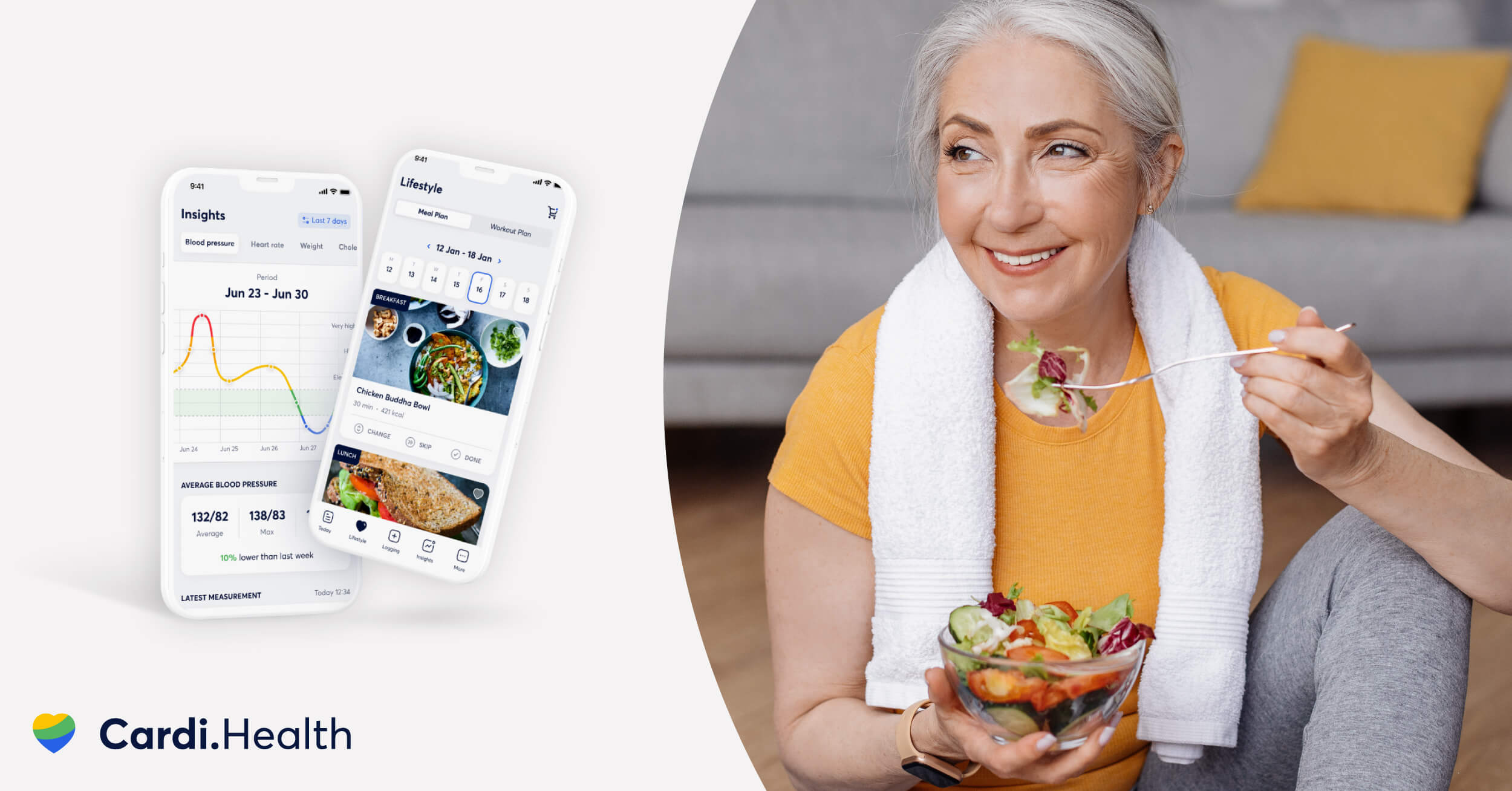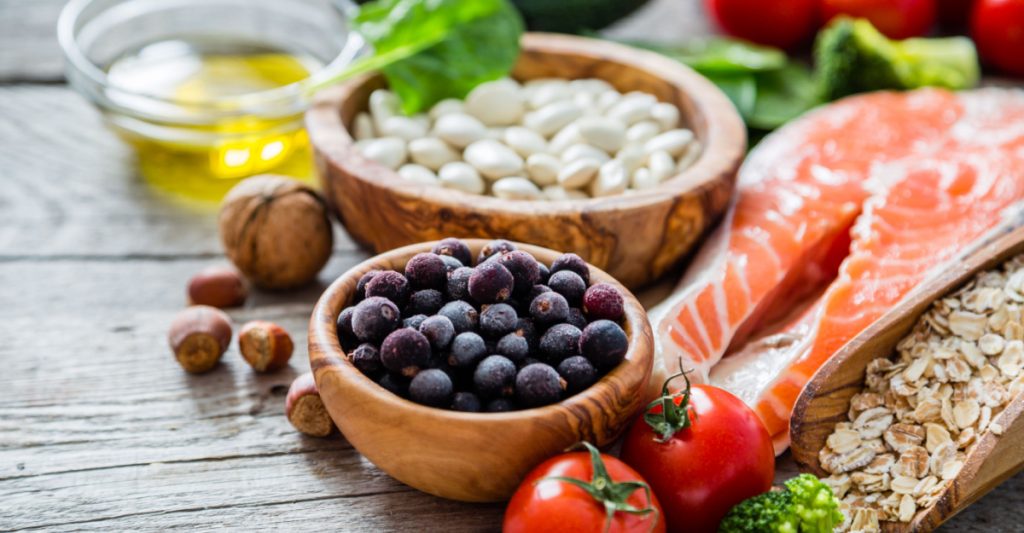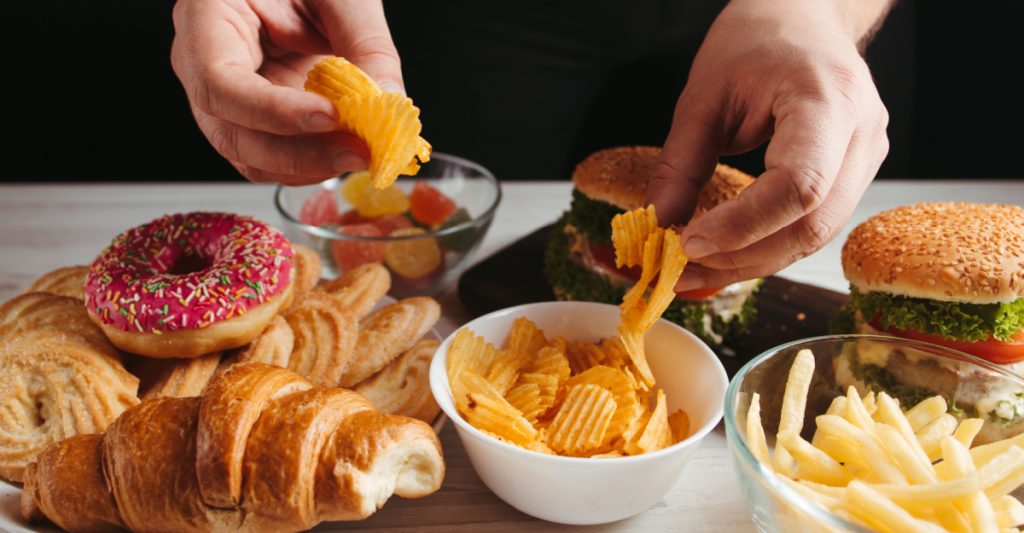20 Healthy Foods That Lower Blood Pressure Naturally
There are many factors that contribute to high blood pressure.
Certain medications and dietary changes may strain your cardiovascular system. Since high blood pressure is treatable, there are ways you can strengthen the heart.
One way includes following a balanced diet, as food determines your long-term health. Sugar and processed foods will only damage your blood vessels even more. This is why you need healthy eating plans that regulate blood pressure throughout the day.
In this article, we tell you the best foods to eat, so keep on reading to find them.

Master your heart health now
Take part in our 60sec quiz and get a heart health plan tailored just for you.
Contents
1. Bananas
Consuming potassium-rich foods like bananas can lower blood pressure.
Potassium helps to ease the tension in your blood vessels. This important mineral regulates the fluid that is stored in the body and released through urine. If you retain too much water due to a high sodium intake, extra fluid is forcefully speeding up blood flow.
Bananas contain 326mg of potassium per 100 grams. The recommended dosage is 3,016mg a day for men and 2,320mg a day for women.
Other benefits of eating bananas include better digestive health. Eating this food will support digestion, as they hold prebiotic fiber. Getting more fiber ensures your gut has a continuous supply of friendly bacteria.
2. Beets, Beet Greens, and Beet Juice
Beetroots are great for lowering blood pressure in the long term.
One study found that people had fewer hypertension symptoms when drinking a cup of beet juice every day for 4 weeks. This is because dietary nitrate can expand the blood vessel walls, which encourages more oxygen-rich blood to reach your heart.
Consuming more nitrates may also improve exercise performance. They bring extra oxygen to muscles, leading to a speedy recovery. You can exercise without feeling sore or exhausted from the day before.
You should aim to drink beet juice, add fresh beets to salads, or cook the beet greens.
3. Berries
Berries contain flavonoids – compounds that can lower high blood pressure. These compounds improve blood vessel function and regulate your systolic blood pressure. This is the top number you see on the measuring machine connected to your arm cuff.
Some of the best berries to eat include:
- Blueberries
- Raspberries
- Strawberries
- Blackberries
Eating more blueberries actually provides many health benefits. The fiber content can lower blood sugar in those with diabetes. Dietary fiber slows down digestion after food consumption, which stops extra glucose from entering the bloodstream.
There are 4 grams of fiber per 1 cup of blueberries. People need at least 20–40 grams of fiber a day to keep their digestive health strong.
Start managing your heart health now!
Find out what works for you with this 60sec quiz.

4. Broccoli
Broccoli consumption has been linked to lower blood pressure. This is because they’re packed with nutrients like potassium, magnesium, and vitamin C. Magnesium-rich foods increase nitric oxide – a signaling molecule that relaxes your blood vessels.
There are 21mg of magnesium in 100 grams of broccoli. Men should aim to get 400–420mg a day, and women need 310–320mg.
Eating lots of broccoli can also boost your immune system. This vegetable contains sulfur – a chemical element that increases glutathione in the body. Glutathione protects your cells from inflammation, which naturally improves immune responses.
5. Carrots
Carrots are great for people who have high blood pressure.
This popular vegetable is high in phenolic compounds – a group of molecules that reduce inflammation and relax blood vessel walls. Eating carrots raw ensures you’re getting enough nutrients, as cooking them could take away some minerals.
The 237mg of potassium in carrots will also lower blood pressure. One amazing benefit of potassium is that it helps your nerves and muscles to function properly. Not getting enough of this mineral could weaken your body in the long term.
6. Celery
Celery has a phytochemical called phthalides. This specific phytochemical strengthens the tissue in your artery walls, leading to healthy blood pressure readings. Phthalides also ensure blood flow is smooth when transporting oxygen-rich cells to the heart.
Vitamin C is another key nutrient that reduces high blood pressure. It removes excess fluid from your body, which stops blood pressure levels from rising.
There is 3.1mg of vitamin C in 100 grams of celery. You need 75–90mg a day when maintaining your long-term heart health.
7. Cinnamon
Studies have shown that consuming 2 grams of cinnamon daily for 8 weeks can reduce blood pressure. Cinnamon dilates and relaxes blood vessels, especially in those who have a body mass index of 30.
Minerals like calcium, potassium, and magnesium are all found in cinnamon. Getting more calcium in a healthy diet could lower blood lipids and high blood pressure. As you probably know, this important mineral is great for strengthening your bones too.
There are 1,000mg of calcium in 100 grams of ground cinnamon. It’s recommended that adults between the age of 19 and 50 should have 2,500mg of calcium a day. Anyone below that age needs 2,000mg to stay healthy.
8. Citrus Fruits
There are certain citrus fruits that lower high blood pressure. They usually contain hesperidin – an antioxidant known for preventing heart disease. One study found that consuming 16fl oz of fresh orange juice can stop hypertension within 12 weeks.
Below, you’ll find the best citrus fruits:
- Grapefruit
- Oranges
- Lemons
Oranges especially hold many important nutrients. There are 59.1mg of vitamin C in this fruit, which reduces oxidative stress, lowers the risk of heart disease, and protects brain health. You should get vitamin C from other foods to reach the recommended intake.
Start managing your heart health now!
Find out what works for you with this 60sec quiz.

9. Fatty Fish
Fatty fish contains omega-3 fatty acids – important fats that reduce blood pressure. A study has proved that consuming 0.7 grams of omega-3 oil can lower systolic blood pressure in 8 weeks, making fish a very essential food in your diet.
Here are some examples of fatty fish you could try:
- Salmon
- Mackerel
- Sardines
- Herring
Salmon is a popular fish that strengthens your heart. It has 1,774mg of omega-3, which lowers blood pressure, plasma triglycerides, and chronic inflammation. You need at least 250–500mg of these fatty acids to prevent high blood pressure symptoms.
10. Garlic

Garlic has a high amount of allicin – an active compound that will lower your blood pressure. One review found that eating garlic can reduce hypertension symptoms, LDL (bad) cholesterol levels, body fat, and artery stiffness from too much pressure.
Allicin is great at lowering the numbers on your measuring machine. Consuming this nutrient decreases systolic blood pressure (top number) by 4–5 points and diastolic blood pressure (bottom number) by 2–3 points, which keeps your heart healthy.
11. Greek Yogurt
Greek yogurt is a nutrient-dense food that prevents high blood pressure. The high levels of potassium and calcium will reduce stress in your artery walls. In one study, people who ate more Greek yogurt had lower arterial pressure compared to those who didn’t.
This type of yogurt also contains phosphorus – a mineral that can regulate blood pressure levels. Phosphorus has been known to release tension in your arteries. Other benefits include stronger bones, muscles, teeth, digestion, and skin tissue.
You should aim to get between 800mg and 1,200mg of phosphorus a day.
12. Herbs and Spices
There are lots of herbs and spices you can choose from when lowering high blood pressure. Most of them contain potassium, magnesium, calcium, iron, and sodium. The body needs iron to produce hemoglobin – a protein that maintains red blood cells.
You can find some herbs and spices below:
- Basil
- Parsley
- Ginger
- Thyme
- Nutmeg
- Cayenne
- Turmeric
Ground ginger has 19.8mg of iron, which can reduce blood pressure. The iron ensures your blood concentrations are healthy and won’t forcefully push through arteries.
Another great benefit of ginger is that it contains anti-inflammatory properties. You can incorporate this spice into meals to eliminate swelling around the heart. Of course, the less inflammation you have, the more likely you’ll avoid heart disease.
Men over 18 need 8.7mg of iron a day, and women aged 19–50 need 18mg a day.
13. Leafy Greens
Leafy green vegetables usually contain lots of nitrates. These nitrogen-based compounds strengthen artery walls and help the blood to pass through. In the long term, your heart will experience less stress, as it doesn’t need to pump blood with force.
Keep reading to find examples of leafy greens:
- Spinach
- Cabbage
- Kale
- Collards
- Lettuce
The most popular choice for a balanced diet is spinach. This superfood can flush sodium out of your system, which prevents any water retention. Potassium is the key ingredient that makes all of this happen in your body.
Spinach also contains 0.45mg of zinc per 100-gram serving. Zinc can boost the immune system, thyroid function, and wound healing mechanisms. You should get at least 8mg of zinc a day if you’re a woman and 11mg a day if you’re a man.
14. Legumes
Legumes often contain lots of fiber and protein.
These two nutrients may control high blood pressure immediately. Protein dilates your blood vessels and decreases the risk of cardiovascular disease.
Here are some great legumes to eat:
- Peas
- Lentils
- Chickpeas
- Kidney beans
- Black beans
Lentils have 24.6 grams of protein per 100 grams. This is enough to lower high blood pressure after consumption. One study found that lentil-based diets can ease your artery walls after 4 weeks, so it’s worth eating more of this food in your diet.
Protein is also great for weight loss, as it fills up your stomach. Fewer hunger cravings may prevent binge eating episodes. You should get 10–35% of your calories from protein-based foods, which could be from legumes or protein weight loss smoothies.
Start managing your heart health now!
Find out what works for you with this 60sec quiz.

15. Oats
Oats are rich in beta-glucan – a type of soluble fiber that turns into a gel-like substance in your stomach. This can help lower high blood pressure, LDL cholesterol, and blood glucose. The gel material will slow down digestion and give your body time to adjust.
Beta-glucan will reduce malondialdehyde, which is a marker for oxidative stress. Having fewer free radicals in your body protects the artery walls.
Some other benefits of oats include a reduced risk of kidney disease, type 2 diabetes, and constipation. There are 10.1 grams of fiber in 100 grams of oats, making it great for your balanced diet.
16. Olive Oil
Olive oil has been known to keep your heart healthy.
The oleic acid and polyphenol content can lower high blood pressure. Oleic acid especially makes your cells more receptive to controlling blood flow in the arteries.
Antioxidant polyphenols are other compounds that make olive oil heart-friendly. They maintain healthy blood pressure while strengthening heart muscles.
Consuming more olive oil could also reduce inflammation, prevent blood clotting, and eliminate LDL cholesterol. People with more bad cholesterol in their bodies usually have a higher risk of heart disease, so it’s important to eat nutrient-dense foods.
17. Pistachios
Pistachios are the best nuts to have if you wish to lower high blood pressure.
They contain monounsaturated fatty acids, which keep your arteries clear of plaque and LDL cholesterol. Of course, the more build-up that occurs in the artery walls, the more likely you’ll have high blood pressure levels.
These delicious nuts are also packed with phytosterols – natural compounds that decrease systolic and diastolic blood pressure. You need plenty of phytosterols to maintain strong heart health, especially if you’re trying to lose weight.
18. Pomegranate
Pomegranates contain lots of antioxidants, which help lower blood pressure. One study found that drinking one cup of pomegranate juice daily led to reduced blood pressure in 28 days. You can still eat this food whole and gain the same physical benefits.
There are 214mg of potassium, 11mg of phosphorus, and 7mg of magnesium in 100 grams of pomegranate juice. All of these nutrients lower blood pressure quickly and minimize hypertension risk in those with diabetes.
19. Seeds
Seeds can help control your blood pressure after food consumption.
They are packed with magnesium, so it’s important to eat more seeds in your diet. As you already know, this mineral strengthens long-term cardiovascular health.
Keep reading to find the best seeds:
- Chia seeds
- Hemp seeds
- Pumpkin seeds
- Flax seeds
Pumpkin seeds contain 550mg of magnesium per 100 grams. This is a high amount compared to other foods on this list. Magnesium is essential for reducing blood sugar levels, boosting exercise, preventing headaches, and combating depression.
20. Tomatoes and Tomato Products
Tomatoes contain lycopene – a type of antioxidant that can help lower blood pressure.
One review found that lycopene is great for reducing hypertension symptoms in those with a weaker heart.
Here are some tomato-based products to have:
- Tomato juice
- Fresh tomatoes
- Tomato paste
Fresh tomato is packed with important nutrients. It contains zinc, magnesium, potassium, copper, and manganese. One great thing about copper is that it stops inflammation from damaging vessels and causing higher blood pressure.
You need 900mcg of copper a day to stay healthy.
Foods to Avoid if You Have High Blood Pressure

You need to avoid certain foods when reducing high blood pressure. Keep reading to find some foods that aren’t good for your long-term heart health.
- Canned soups
- Pickles (and any salt-based product)
- Sugary beverages (soda, milkshakes, energy drinks, etc.)
- Processed meat (hot dogs, sausages, cured bacon, salami, etc.)
- Alcohol
- White bread (including rolls, pizza, and white dough products)
- Red meat (pork, beef, lamb, etc.)
- Sweet desserts (chocolate, puddings, biscuits, candy, etc.)
- Condiments (ketchup, salad dressings, soy sauce, etc.)
- Oils (coconut, cream, and palm)
- Full-fat dairy products
- Caffeine (suitable in moderation)
All of these foods contain high amounts of sugar, salt, and saturated fat. These ingredients promote high blood pressure in those with hypertension. Of course, you can eat some in moderation, but always focus on fresh fruit, vegetables, and whole grains.
What Else Can You Do to Lower Blood Pressure?
There are many things you can do to reduce high blood pressure naturally. Taking medication isn’t always the only solution, so exploring effective home remedies can greatly improve your heart health.
- Get some regular daily exercise
- Reduce the amount of sodium in your diet
- Lose some stubborn weight
- Try to quit smoking
- Have at least 6–8 hours of sleep every night
- Limit your alcohol consumption
- Avoid eating processed foods
- Monitor your blood pressure levels every day
If you need more guidance when managing your heart health, Cardi Health will help you. Cardi Health is a comprehensive app designed to help you track and manage your cardiovascular well-being. This app provides valuable tools and resources, including personalized heart health monitoring, daily reminders, lifestyle tips, and expert guidance. Take control of your heart health today with Cardi Health and experience the benefits of a healthier lifestyle.
Start managing your heart health now!
Find out what works for you with this 60sec quiz.

FAQ
Which foods are effective in lowering blood pressure?
Leafy greens, berries, beets, oats, and fatty fish are among the foods that help reduce blood pressure naturally.
How do berries aid in reducing blood pressure?
Berries contain antioxidant compounds called flavonoids, which have been shown to lower blood pressure.
Are fatty fish beneficial for people with hypertension?
Yes, fatty fish like salmon and mackerel are rich in omega-3 fatty acids that can lower blood pressure and reduce inflammation.
How do oats contribute to blood pressure management?
Oats contain beta-glucans, a type of soluble fiber that can help lower blood pressure by improving blood vessel function.
Conclusion
So, can these foods really manage blood pressure levels?
You should try to incorporate some of these foods into your diet. They will help reduce blood pressure and keep the heart functioning properly. Always focus on eating whole grains, fresh fruits (mainly citrus), nuts, seeds, and leafy green vegetables.
Related articles
Best Foods to Lower Cholesterol
Does Caffeine Raise Blood Pressure?
Does Drinking Water Lower Blood Pressure?
Causes of High Blood Pressure at Night
10 DASH Diet Breakfasts for a Healthy Start
Heart-Healthy Diet Guide
What Should an 85-Year-Old Blood Pressure Be?
What is Normal Blood Pressure for a 70-Year-Old?
How to Read Blood Pressure: A Comprehensive Guide
Manage your heart health now
Find out what works best for you with this 60sec quiz and get your personalized heart health plan.

